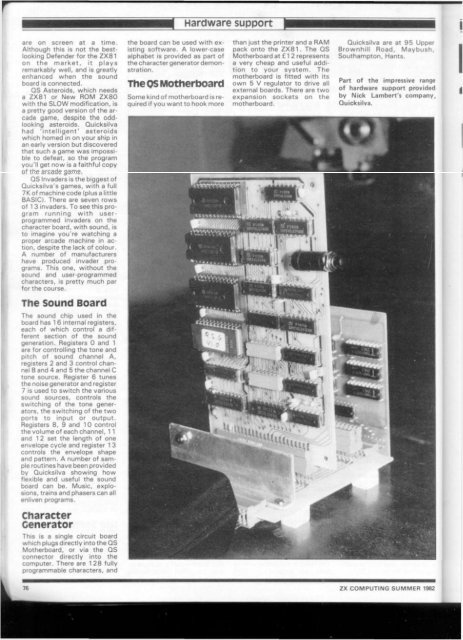ZX Computings - OpenLibra
ZX Computings - OpenLibra
ZX Computings - OpenLibra
You also want an ePaper? Increase the reach of your titles
YUMPU automatically turns print PDFs into web optimized ePapers that Google loves.
are on screen at a time.<br />
Although this is not the bestlooking<br />
Defender for the <strong>ZX</strong>81<br />
on the market, it plays<br />
remarkably well, and is greatly<br />
enhanced when the sound<br />
board is connected.<br />
QS Asteroids, which needs<br />
a <strong>ZX</strong>81 or New ROM <strong>ZX</strong>80<br />
with the SLOW modification, is<br />
a pretty good version of the arcade<br />
game, despite the oddlooking<br />
asteroids. Quicksilva<br />
had 'intelligent' asteroids<br />
which homed in on your ship in<br />
an early version but discovered<br />
that such a game was impossible<br />
to defeat, so the program<br />
you'll get now is a faithful copy<br />
of the arcade game,<br />
QS Invaders is the biggest of<br />
Quicksilva's games, with a full<br />
7K of machine code (plus a little<br />
BASIC). There are seven rows<br />
of 13 invaders. To see this program<br />
running with userprogrammed<br />
invaders on the<br />
character board, with sound, is<br />
to imagine you're watching a<br />
proper arcade machine in action,<br />
despite the lack of colour.<br />
A number of manufacturers<br />
have produced invader programs.<br />
This one, without the<br />
sound and user-programmed<br />
characters, is pretty much par<br />
for the course.<br />
The Sound Board<br />
The sound chip used in the<br />
board has 1 6 internal registers,<br />
each of which control a different<br />
section of the sound<br />
generation. Registers 0 and 1<br />
are for controlling the tone and<br />
pitch of sound channel A,<br />
registers 2 and 3 control channel<br />
B and 4 and 5 the channel C<br />
tone source. Register 6 tunes<br />
the noise generator and register<br />
7 is used to switch the various<br />
sound sources, controls the<br />
switching of the tone generators,<br />
the switching of the two<br />
ports to input or output.<br />
Registers 8, 9 and 10 control<br />
the volume of each channel, 11<br />
and 12 set the length of one<br />
envelope cycle and register 1 3<br />
controls the envelope shape<br />
and pattern. A number of sample<br />
routines have been provided<br />
by Quicksilva showing how<br />
flexible and useful the sound<br />
board can be. Music, explosions,<br />
trains and phasers can all<br />
enliven programs.<br />
Character<br />
Generator<br />
This is a single circuit board<br />
which plugs directly into the QS<br />
Motherboard, or via the QS<br />
connector directly into the<br />
computer. There are 128 fully<br />
programmable characters, and<br />
the board can be used with existing<br />
software. A lower-case<br />
alphabet is provided as part of<br />
the character generator demonstration.<br />
The OS Motherboard<br />
Some kind of motherboard is required<br />
if you want to hook more<br />
Hardware support<br />
than just the printer and a RAM<br />
pack onto the <strong>ZX</strong>81. The QS<br />
Motherboard at £ 1 2 represents<br />
a very cheap and useful addition<br />
to your system. The<br />
motherboard is fitted with its<br />
own 5 V regulator to drive all<br />
external boards. There are two<br />
expansion sockets on the<br />
motherboard.<br />
/<br />
M M<br />
wmi<br />
Quicksilva are at 95 Upper<br />
Brownhill Road, Maybush,<br />
Southampton, Hants.<br />
Part of the impressive range<br />
of hardware support provided<br />
by Nick Lambert's company,<br />
Quicksilva.<br />
76 <strong>ZX</strong> COMPUTING SUMMER 1982
















